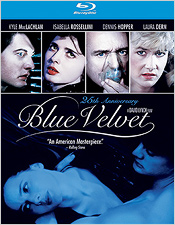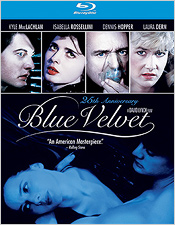Blue Velvet: 25th Anniversary Edition (Blu-ray Review)

Director
David LynchRelease Date(s)
1986 (November 8, 2011)Studio(s)
MGM (20th Century Fox Home Entertainment)- Film/Program Grade: A-
- Video Grade: A-
- Audio Grade: A
- Extras Grade: A
Review
Since the release of Inland Empire in 2006, David Lynch has been busy pursuing pretty much everything except feature filmmaking. He’s been an advocate for transcendental meditation, developed an active online presence, introduced his own signature blend of coffee, and most recently, released his first solo album as a musician, Crazy Clown Time.
For his entire career, Lynch has done basically whatever he’s wanted to do and clearly that’s never going to stop. If he wants to write, sing and record a CD of experimental synth-pop tunes, he’ll do just that. But whether you love or hate Lynch’s recent pursuits, it’s hard not to wish that he’d get behind a camera again, especially after revisiting his 1986 breakthrough film, Blue Velvet.
Lynch himself described Blue Velvet as The Hardy Boys Go to Hell and that’s not a bad summation. Kyle MacLachlan stars as Jeffrey Beaumont, summoned back home to Lumberton, USA, after his father suffers a stroke while watering the lawn. Walking home from the hospital, Jeffrey discovers a severed human ear in the middle of a field. Good citizen that he is, he brings the ear to the attention of his neighbor; police Detective Williams (played by George Dickerson). His curiosity unsatisfied by the cop’s evasive answers, Jeffrey teams up with Sandy, the girl next door (Laura Dern), to do some amateur sleuthing. They connect the ear (figuratively, anyway) to nightclub singer Dorothy Vallens (Isabella Rossellini). Through her, the trail leads to Frank Booth (Dennis Hopper), an unhinged psycho who carts around a gas mask to take hits of nitrous oxide. Once Frank enters the picture, things rapidly spiral out of control and Jeffrey finds himself in a world more disturbing and dangerous than anything he’d ever imagined.
Blue Velvet marked a major turning point in David Lynch’s career. Lynch had followed up the midnight-movie success of Eraserhead and the popular and critical hit The Elephant Man with his disastrous adaptation of Frank Herbert’s Dune. With Blue Velvet, Lynch refocused his energies on a project that was his and his alone. The movie polarized the critics but became an art-house smash. It was the cornerstone of Hopper’s 1986 comeback trifecta (which also included River’s Edge, Hoosiers and, for some of us anyway, The Texas Chainsaw Massacre 2) and earned Lynch a surprise Best Director nomination at the Academy Awards.
Personally, Blue Velvet has never quite done it for me the way Lynch’s more recent films have, and I think I’ve finally started to figure out why. Lynch would continue to explore the themes and ideas he introduced here, most obviously when he probed the secrets of an idyllic small town called Twin Peaks. But the same off-center feeling can be found in movies like Lost Highway and Mulholland Drive. With these films, the mystery is almost beside the point. The lack of any sort of rational explanation for the events in these films gives them, for me anyway, a greater resonance and much darker feeling.
Jeffrey ultimately does “solve” the Case of the Severed Ear, not that the solution gives him much comfort. For me, the best, most memorable sequences in Blue Velvet are those with no rhyme or reason… they just are. Images like Dean Stockwell lip-synching Roy Orbison’s “In Dreams” into an industrial lamp or Jeffrey’s discovery of the two eerily posed corpses toward the end of the movie are extraordinarily haunting. And the performances, particularly Rossellini and Hopper, are all top-notch. Nobody but Hopper could turn Pabst Blue Ribbon into a line that’s both funny and frightening at the same time. Besides, if you’re any kind of David Lynch fan, you must at the very least appreciate this movie. Without Blue Velvet, there would be no Twin Peaks.
Fans will be happy to know that Lynch was heavily involved with this new 25th Anniversary Blu-ray release, personally supervising the new 1080p transfer. The results are absolutely stunning. The colors are gorgeous and vivid, while the fine details are extraordinary. You feel like you could reach out and touch the blue velvet curtains that sway beneath the opening and closing credits. The audio, presented in 5.1 DTS-HD Master Audio, is immersive without losing any of its subtlety. I don’t think “In Dreams” has ever sounded as good.
Most of the special features from the previous DVD release have been brought over to the Blu-ray, albeit in standard definition. Key among them is the outstanding 70-minute documentary Mysteries Of Love. Other holdovers include the Siskel and Ebert review, the trailer and two TV spots, and brief interview snippets previously hidden as Easter eggs, now collected under the title Vignettes. The DVD also included a photo gallery and that has not been included on the Blu-ray.
But the big news is the inclusion of almost an hour of recently discovered lost footage. The DVD’s “deleted scenes” were reconstructed through still photographs, as the actual footage couldn’t be found. Now we finally get to see the real deal (in HD, no less) and it’s fascinating. Most of the scenes flesh out the back story of Kyle MacLachlan’s character, Jeffrey. We see him at school getting the news about his father’s health and learn about his rocky relationship with his girlfriend (played by Megan Mullally!). Lynch did the right thing by cutting these scenes, not because they’re bad but simply because they aren’t necessary. Still, it’s great to finally see them. Also new to the Blu-ray are some brief outtakes, nothing earth-shattering but still fun to see. One odd thing about the disc, which seems to be common among MGM catalog titles: there is no main menu. The movie just starts and plays again afterwards on an endless loop. You need to use a pop-up menu to access the controls.
With a noticeable improvement in video and audio and the inclusion of the lost footage, Lynch fans shouldn’t hesitate in upgrading Blue Velvet to Blu-ray. Watching it again, I understood a bit more why Lynch walked away from filmmaking. Sad to say, there isn’t a place for his unique sensibility in today’s market. I can’t imagine how difficult it would be to make Blue Velvet today. His voice is sorely missed and I hope that someday, it will come back. If David Lynch wants to make a movie, nobody should be able to tell him he can’t.
- Dr. Adam Jahnke

